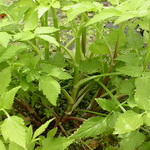| Common Name: |
Water Dropwort |
| Other Names: |
Vietnamese Celery, Korean Watercress, Seri |
| Botanical Name: |
Oenanthe javanica syn. O. japonica, O. stolonifera |
| Genus: |
Oenanthe |
| Family: |
Apiaceae |
| Location: |
India to Japan, also in Taiwan, Malaysia, and N Australia (Queensland) |
| Cultivation: |
Damp to wet soil in sun or partial shade. Invasive |
| Propagation: |
By division or stem-tip cuttings in spring. Roots readily in water. |
| Harvest: |
Young shoots are picked for culinary use from autumn to spring in warm areas, and from spring to summer in areas with cold winters. Whole plant, leaves and fruits are collected later in the growing season for medicinal use, usually in the form of decoctions. |
| Height: |
20-80cm (8-32in) |
| :Width |
90cm (36in) |
| Variations: |
Flamingo
Has pink, white and cream variegation.
Height:15-20cm (6-8in) |
| Hardiness: |
Z8-11 |
| Parts Used: |
Whole plant, leaves, young shoots, fruits. |
| Properties: |
A pleasant tasting, aromatic herb with cleansing, diuretic, and carminative effects. It lowers fevers and controls bleeding. |
| Medicinal Uses: |
Internally for fever in influenza, blood in urine, and heavy menstruation. Externally as a poultice for poisonous bites, abscesses, and malignant swellings. |
| Culinary Uses: |
Young shoots are eaten raw, steamed, stir-fried, or added to other dishes; also as a flavoring for soups. Traditionally eaten with six other herbs in Japan during festivals on January 7 and 15. |
| Bibliography: |
Encylopedia of Herbs by Deni Brown Copyright ©: 1995, 2001 Dorling Kindersley Limited pg.293
|
